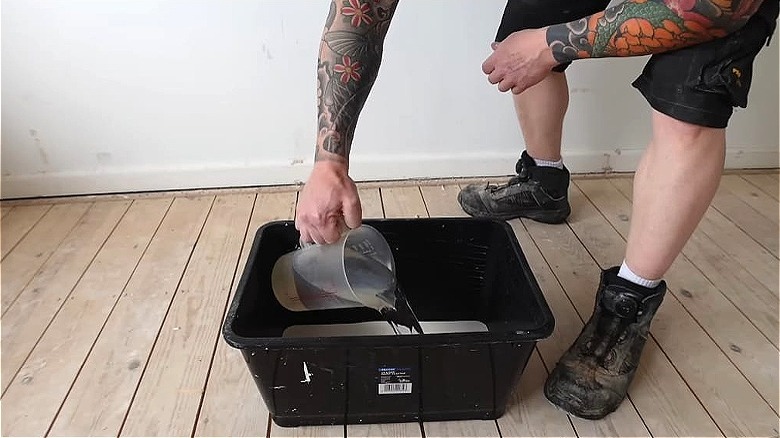What Is A 'Mist Coat' And Why Will You Want One When Painting Your Wood Stairs
We may receive a commission on purchases made from links.
Ever stared at those modern staircases in photos while side-eyeing your less-than-stellar wooden stairs, feeling a tad moping? Cue the bombastic side-eye trend. Trust us; we know the feeling. Painting wood stairs can sometimes feel like an uphill battle (quite literally), which one might even liken to trying to tame a wild, wooden beast with a thin brush. But if there were an ultimate secret weapon for taking that wooden stair paint job from "whoops" to "wow," it would be a mist coat. It's a relatively thin, diluted coat of paint applied before the full paint job, providing a smooth and harmonious base layer to your wooden canvas. This gallant knight of the staircase realm is achieved by diluting regular paint with water, but the specific mist coat ratio figures vary with the paint's viscosity.
You certainly don't fancy watching paint dry in patchy, chaotic streaks. Employing a mist coat before your full-blown paint job is like donning a superhero's cape before saving the day. It's a smooth operator, clinging to your wood stairs like a lovable barnacle and providing an even zone, free of trials and tribulations of painting over wood. Your paint, once used to angrily fighting its noble yet futile battle, will now blend seamlessly and obediently onto the surface, nailing that elusive even finish. One of the bonuses is that it could save you a bob or two by reducing the use of that precious, color-popping paint.
Perfecting your wood stair paint job with mist coating
Mist coat, often synonymous with painting new, dry plaster, beats adhesion snags. It quenches the thirsty plaster, acting as a primer whose extra moisture aids the topcoat in sticking firmly. Now, let's give this theory a wooden twist. Unpainted wood is porous and would slurp up liquids like a parched marathon runner — only it's guzzling your precious paint. A mist coat balances out things. So, how do you apply a mist coat of paint? Start by diluting emulsion paint with water. Quick alert: Ensure your emulsion paint is purely acrylic, as silk or vinyl spoil the fun with peels. In addition, play the matchmaker and get a mist coat paint that pairs nicely with your topcoat's color.
A paint-water ratio (mist coat ratio) of 75/25, 70/30, or an equal 50/50 often steals the show, factoring in the emulsion's thickness. A stirring tool like the Homax PolyPro Squirrel Mixer from The Home Depot aids consistency. But then, is it better to use a roller or brush for a mist coat? If speed is a priority, use a roller (though it might fling paint astray). A paintbrush is less messy, though slower. As for the optimum number of layers of mist coat, one will do. But if feeling extra cautious, add a second or a third, letting each layer dry for 24 hours. As for how to tell if the mist coat worked, try the masking tape test: A clean peal indicates success.
More benefits of a mist coat for your wooden staircase
Picture the mist coat as the wizard behind the curtain, an unexpected powerhouse in wood painting. It parallels an introvert at a party. Initially overlooked, but once it gets going, everyone wonders how they bypassed such an enigma. The obvious trick lies in improved paint adherence. Switching hats to that of a secret agent, it infiltrates the porous surfaces on your wooden staircase. Instead of allowing the paint to wander off into wild territories, it keeps it focused, avoiding those heartbreaking moments of flaking or bubbling.
Then, there's the matter of durability. Here, the mist coat operates like a tough personal trainer, pushing the topcoat to withstand daily wear and tear, transforming it into a beacon of resilience. Think of it as the durability fairy, sprinkling longevity dust and gifting your wooden staircase a long-lasting finish worth bragging about. Lastly, don't overlook the economic superhero cap the base coat dons. By sealing the pores and thus reducing the absorbency of your stairs, it haggles the amount of topcoat needed to a reasonable minimum. This adherence minimizes the likelihood of premature paint failures that would demand more money to fix. Execute the base coat properly, and you'll bask in the glory of a consistent, smooth-as-butter finish, an outcome a far cry from a patchwork quilt.


